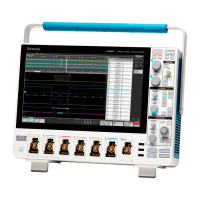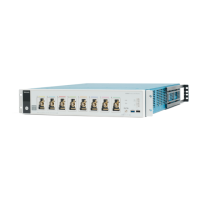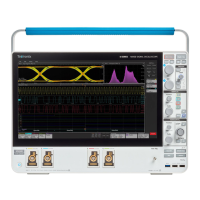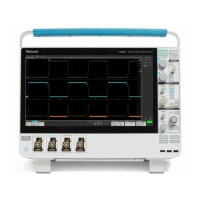3. T
urn on (display on screen) the connected channels that you want to deskew.
4. Double-tap in the Waveform view and set Waveform Mode to Overlay.
5. Push the Autoset button.
6. Adjust the vertical Scale and Position controls for each channel so that the signals overlap and are centered on the display.
7. Adjust the horizontal Scale so that the differences in the channel delays are clearly visible.
8. Determine the channel you want to use as your reference.
9. Double-tap the Channel badge of a channel other than the reference channel and tap the Other panel.
10. Tap the Deskew field and use the multipurpose knob to align this channel with the reference channel waveform such that the
waveforms cross the trigger point at the same time. For fine adjust, double-tap the Deskew field to open a number pad.
11. Repeat steps 9 and 10 for each additional channel you want to deskew.
12. To deskew additional channels:
a. Disconnect all probe tips except the reference probe from the Probe Compensation connections.
b. Connect up to three probe tips and ground leads to the Probe Compensation connector (maximum of four channels at a time).
c. Repeat steps 3 through 12 for the additional channels to deskew.
Connect a keyboard or mouse
The instrument supports most standard USB-connected keyboards and mice, and wireless-connected keyboards and mice (using a
USB-connected dongle).
Connect a keyboard and/or mouse by connecting their USB cable, or USB dongle, into any available USB Host port. The keyboard or
mouse should work immediately. If it does not, try the following:
1. Remove and reinsert the USB cable or dongle in the same port.
2. Insert the USB cable or dongle into a different USB port.
ESD Prevention Guidelines
Electrostatic discharge (ESD) can damage oscilloscope and some probe inputs. This topic discusses how to avoid this type of damage.
Electrostatic discharge (ESD) is a concern when handling any electronic equipment. The instrument is designed with robust ESD
protection, however it is still possible that large discharges of static electricity directly into the signal input may damage the instrument. Use
the following techniques to prevent electrostatic discharge from damaging the instrument.
• Discharge the static voltage from your body by wearing a grounded antistatic wrist strap while connecting and disconnecting cables,
probes, and adapters. The instrument provides a ground connection to which to attach a wrist strap (on the Probe Comp ground
connector).
• A cable that is left unconnected on a bench can develop a large static charge. Discharge the static voltage from all cables before
connecting them to the instrument or device under test by momentarily grounding the center conductor of the cable, or by connecting a
50 Ω termination to one end, before attaching the cable to the instrument.
• Before you apply power, connect the instrument to an electrically-neutral reference point, such as earth ground. To do this, plug the
three-pronged power cord into an outlet grounded to earth ground. Grounding the oscilloscope is necessary to ensure safety and to
take accurate measurements.
• If you are working with static sensitive components, ground yourself. Static electricity that builds up on your body can damage
static-sensitive components. Wear a wrist strap to safely send static charges on your body to earth ground.
• The oscilloscope must share the same ground as any circuits that you plan to test.
Configure the instrument
56
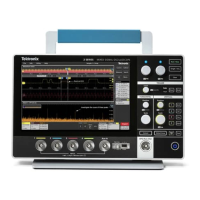
